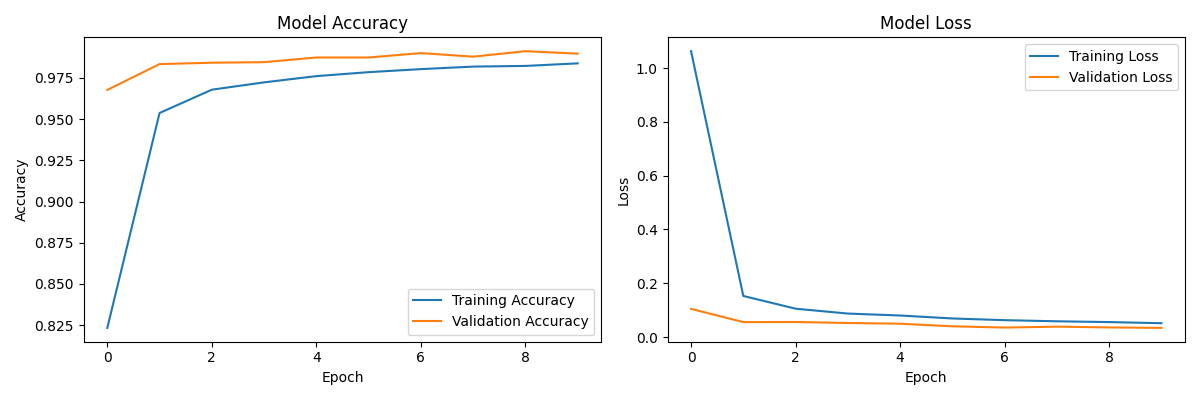The MNIST OCR (Optical Character Recognition) model is a deep learning model trained to recognise and classify handwritten digits from 0 to 9. This model is trained on the MNIST dataset, which consists of 60,000 small square 28×28 pixel grayscale images of handwritten single digits, making it highly accurate for recognising written, isolated digits in a similar style to those found in the training set.
Install Packages
pip install numpy opencv-python requests pillow transformers tensorflow
Usage
import os
os.environ["KERAS_BACKEND"] = "tensorflow"
import keras
import numpy as np
import cv2
import requests
from PIL import Image
from io import BytesIO
from typing import List, Optional
from huggingface_hub import hf_hub_download
import tensorflow as tf
import pickle
class ImageTokenizer:
def __init__(self):
self.unique_pixels = set()
self.pixel_to_token = {}
self.token_to_pixel = {}
def fit(self, images):
for image in images:
self.unique_pixels.update(np.unique(image))
self.pixel_to_token = {pixel: i for i, pixel in enumerate(sorted(self.unique_pixels))}
self.token_to_pixel = {i: pixel for pixel, i in self.pixel_to_token.items()}
def tokenize(self, images):
return np.vectorize(self.pixel_to_token.get)(images)
def detokenize(self, tokens):
return np.vectorize(self.token_to_pixel.get)(tokens)
class MNISTPredictor:
def __init__(self, model_name):
# Download the model and tokenizer files
model_path = hf_hub_download(repo_id=model_name, filename="mnist_model.keras")
tokenizer_path = hf_hub_download(repo_id=model_name, filename="mnist_tokenizer.pkl")
# Load the model and tokenizer
self.model = keras.models.load_model(model_path)
with open(tokenizer_path, 'rb') as tokenizer_file:
self.tokenizer = pickle.load(tokenizer_file)
def extract_features(self, image: Image.Image) -> List[np.ndarray]:
"""Extract features from the image for multiple digits."""
# Convert to grayscale
gray = cv2.cvtColor(np.array(image), cv2.COLOR_RGB2GRAY)
# Apply Gaussian blur
blurred = cv2.GaussianBlur(gray, (5, 5), 0)
# Apply adaptive thresholding
thresh = cv2.adaptiveThreshold(blurred, 255, cv2.ADAPTIVE_THRESH_GAUSSIAN_C, cv2.THRESH_BINARY_INV, 11, 2)
# Find contours
contours, _ = cv2.findContours(thresh, cv2.RETR_EXTERNAL, cv2.CHAIN_APPROX_SIMPLE)
digit_images = []
for contour in contours:
# Filter small contours
if cv2.contourArea(contour) > 50: # Adjust this threshold as needed
x, y, w, h = cv2.boundingRect(contour)
roi = thresh[y:y+h, x:x+w]
resized = cv2.resize(roi, (28, 28), interpolation=cv2.INTER_AREA)
digit_images.append(resized.reshape((28, 28, 1)).astype('float32') / 255)
return digit_images
def predict(self, image: Image.Image) -> Optional[List[int]]:
"""Predict digits in the image."""
try:
digit_images = self.extract_features(image)
tokenized_images = [self.tokenizer.tokenize(img) for img in digit_images]
predictions = self.model.predict(np.array(tokenized_images), verbose=0)
return np.argmax(predictions, axis=1).tolist()
except Exception as e:
print(f"Error during prediction: {e}")
return None
def download_image(url: str) -> Optional[Image.Image]:
"""Download an image from a URL."""
try:
response = requests.get(url)
response.raise_for_status()
return Image.open(BytesIO(response.content))
except Exception as e:
print(f"Error downloading image: {e}")
return None
def save_predictions_to_file(predictions: List[int], output_path: str) -> None:
"""Save predictions to a text file."""
try:
with open(output_path, 'w') as f:
f.write(f"Predicted digits are: {', '.join(map(str, predictions))}\n")
except Exception as e:
print(f"Error saving predictions to file: {e}")
def main(image_url: str, model_name: str, output_path: str) -> None:
try:
predictor = MNISTPredictor(model_name)
# Download image
image = download_image(image_url)
if image is None:
raise Exception("Failed to download image")
print(f"Image downloaded successfully.")
# Predict digits
digits = predictor.predict(image)
if digits is not None:
print(f"Predicted digits are: {digits}")
# Save predictions to file
save_predictions_to_file(digits, output_path)
print(f"Predictions saved to {output_path}")
else:
print("Failed to predict digits.")
except Exception as e:
print(f"An error occurred: {e}")
if __name__ == "__main__":
image_url = "https://miro.medium.com/v2/resize:fit:720/format:webp/1*w7pBsjI3t3ZP-4Gdog-JdQ.png"
model_name = "0xnu/mnist-ocr"
output_path = "predictions.txt"
main(image_url, model_name, output_path)
Copyright
(c) 2024 Finbarrs Oketunji. All Rights Reserved.
- Downloads last month
- 54
This model does not have enough activity to be deployed to Inference API (serverless) yet. Increase its social
visibility and check back later, or deploy to Inference Endpoints (dedicated)
instead.
